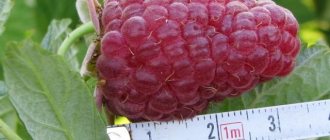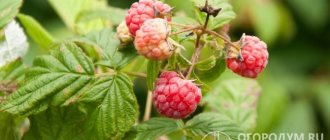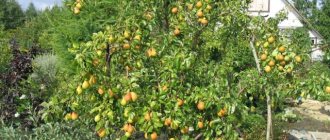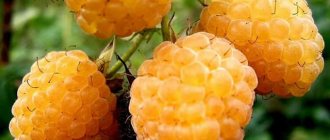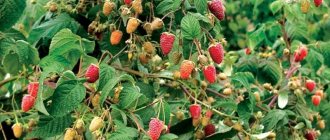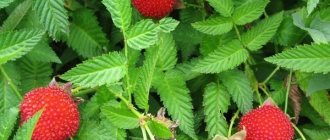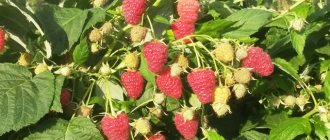History of the Zyugana variety
The first remontant varieties appeared 200 years ago, but their autumn fruiting zone was insignificant. In world breeding, work was purposefully carried out to create new productive forms of the remontant type, which have attractive large berries and tolerate transportation well. In 1999, as a result of crossing Terri-Louise and Joan Squre raspberries, the Swiss company Lubera managed to obtain the universal variety Zyugana. Since then, these remontant raspberries have been successfully grown both in garden plots and on industrial plantations, not yielding to the leading positions of the newly created varieties.
Zyugana is a remontant variety created by Swiss breeders
Prevention of diseases and pests
Raspberry Golden Zyugana is weakly affected by major diseases, and even less often attacked by parasites. Late flowering does not coincide with the phases of pest activity. But prevention is never superfluous:
- Avoid thickening - sunlight kills many diseases and pests.
- Promptly cut out old, diseased, dried or frozen shoots.
- Removing weeds is a haven for parasites.
- Digging between rows destroys the nests of pests and their larvae.
- Treat the plantings with a 1% solution of Bordeaux mixture, 2 times with an interval of two weeks, before flowering begins.
More on the topic: Yellow raspberries of the Chelyabinsk variety
If parasites do appear on the bushes, they should be treated with Actellik. During flowering, only biological products are allowed.
Description of the variety
Zyugana is a remontant raspberry variety that produces fruit in the summer and bears fruit again in late summer, until frost. However, for regions with quickly approaching autumn cold, it is more effective to grow these raspberries with one-time returns. The second wave of fruiting occurs at the end of the season, when in many regions of Russia and Belarus it is damp and cold. With prolonged rainfall or frost-stricken fruits, they become more watery and soft, and individual drupes may rot. However, the problem of late yield can be solved by growing bushes in film greenhouses or covering them on top of a trellis with non-woven material.
In damp, cold climates, it is more advisable to grow Zyugana raspberries indoors
The Zyugana variety showed itself best in the south of Ukraine: thanks to its heat resistance and drought resistance, the berries do not bake in the sun without shading (which is very important for commercial cultivation on large plantations) and have time to ripen on annual shoots at the end of the season, since the climate here is mild and warm.
Ripe berries do not crumble, but only darken slightly
The ripening time for raspberries on two-year-old shoots is the second decade of June; the second harvest begins in mid-August and lasts until late autumn. Gardeners and farmers recognize the variety as very promising due to its consistently high yield - up to 9 kg can be harvested from one bush per season and the excellent taste of the fruit.
Gardeners value the Zyugany variety for its beautiful fruits and high yields
Reviews
I planted Zyugana raspberries with thin twigs, no more than 3-5 mm in diameter. Everyone, without exception, took root. The growth was confident, the shoots grew under 2 m. The first berries were no more than 5 grams. From the middle of fruiting, most of the berries weighed 7-10 grams. The taste is good, transportability is excellent. Productivity is high. In general, the variety showed itself fully.
I have been looking for a raspberry variety for the garden for two years. I read a lot of rave reviews about the Zyugana raspberry, purchased it and planted it in the fall. In the first year the harvest was modest, but the berries were very tasty and fragrant. In the following years, there were more shoots and the berries became larger. A small garden bed is enough for us to prepare enough food for the whole family to eat.
Zyugana raspberries are a rare variety that satisfies gardeners in every way. In any climate zone it can be adapted for high-quality fruiting. It is important to create the most necessary conditions for this shrub: light, warmth, watering and fertilizing. Attention and care will be rewarded with excellent results.
Characteristics of Zyugana raspberries
The bushes are strong, compact, 60–70 cm wide, 1.5–1.7 m high, and can grow up to 1.9 m. They have good survival rate and multiply quickly. Powerful, vertically growing branches do not bend under the weight of the crop and can be grown without additional support. The shoots are weakly spiny, branch very well, and form 250–300 fruit ovaries. The large leaves are bright green and slightly wrinkled.
Zyugana raspberry bushes are strong, tall, all strewn with berries
The fruits are rounded and elongated, bright red with a raspberry tint, shiny, large, with an average weight of 5–7 g; if agricultural techniques are followed, they can reach 12 g. The pulp is juicy, with a bright aroma, sweet with a slightly noticeable sourness, which successfully emphasizes the rich flavor gamma. It is inferior to Polka in terms of the amount of sugars, but has a richer, refreshing taste. Ripe berries do not fall off the branches, are denser in structure than Polka's, and tolerate transportation well.
The shape of Zyugana berries is rounded and elongated, the color is bright red with a raspberry tint.
A universal-purpose variety, used for fresh consumption, freezing, making jam, compotes, and jellies. It has good shelf life - it does not lose its marketable qualities within 4 days, and the berries can be stored in the refrigerator for a week. Raspberries tolerate winter cold well, but in case of severe frosts (more than -300C), it is advisable to insulate the bushes with agrofibre.
Large berries with dense pulp are well stored after picking.
Zyugana today is considered one of the most promising remontant varieties, but it also has its drawbacks. Among the disadvantages, late ripening in autumn can be noted. Therefore, in the northern regions it is more effective to grow it as an annual crop, cutting off all shoots for the winter. Also, in damp, cold climates, the variety exhibits reduced resistance to root rot.
Video: Zyugana raspberry - remontant variety-timer
Features of care
After planting shrubs on your site, quality care is considered key to achieving a harvest. The most important step in caring for raspberries is their regular pruning. Autumn pruning of shoots that have given up the harvest occurs after the last harvest.
Shrubs are rationed, since on strong autumn shoots, thin, frail shoots will grow, which will draw nutritional components from the soil and the plant. Therefore, in order to optimize the life resource of the plant for a bountiful harvest, all young and weak shoots are cut off. Thus, the plant should have about 8-9 branches left.
During spring pruning, all young and frail shoots are cut off, leaving no more than 10 shoots.
After pruning, tying is carried out. To form juicy and aromatic berries on raspberry bushes, the plant needs watering, the best type of which is considered drip.
Raspberries need mulching; under such conditions, moisture will be retained in the root zone, there will be no cracks in the soil, and there will be no growth of weeds.
Pinching the growth point of young shoots is carried out at the end of spring, when the bush reaches the mark of 90-100 cm. This will serve as an impetus for intensive vegetation, at the same time, the autumn harvest will shift somewhat in time.
Top dressing at the beginning of spring consists of a mineral-nitrogen complex (saltpeter, nitroammophoska).
Before flower buds begin to bloom and during the formation of the ovary, foliar (leaf) feeding should be carried out using: potassium, calcium, phosphorus with a small nitrogen content.
Raspberries need several feedings during the period of fruit formation and ripening, so in the spring, after the snow melts, urea is added.
To form large, juicy and dense berries, potassium nitrate and complex mineral fertilizers are used as fertilizers.
The raspberry plant needs periodic removal of weeds and loosening of the soil. It is recommended to loosen the soil under each bush and between the rows after each irrigation or rain, if there is no mulch under the plants.
Raspberries are harvested as the berries ripen. If you plan long transportation or long-term storage of fruits, it is best to harvest early in the morning.
The excellent appearance of the berries, a very high yield, as well as the ability to store and transport make this variety one of the most promising for cultivation for subsequent sale. Sugana raspberries produce a large amount of shoots, which makes propagation much easier. The variety grows without problems and shows excellent survival rate in household plots and garden plots.
Agricultural technology of Zyugana raspberries
Remontant raspberries are more demanding of nutrition and moisture. Only by regularly watering and feeding berry bushes can you count on generous harvests.
Watering and loosening
The drought-resistant Zyugana variety tolerates the hot climate of southern Russia well; the berries do not bake in the sun, but will be much juicier with abundant irrigation. Once a week, and more often in case of prolonged absence of precipitation, the bushes should be watered (the norm is a bucket per plant), moistening the soil to a depth of 40 cm.
The soil under the raspberry bushes must be wetted to a depth of 40 cm, where the main roots are located.
Considering the variety’s propensity to diseases of the root system, flooding during spring floods and stagnation of water during the rainy season should be avoided. In autumn, if the weather is dry, on the eve of frost the bushes are watered abundantly (20 l per plant).
Summer residents usually moisten raspberry plants through grooves laid between rows or made around individual bushes. Water is added to grooves 10 cm deep, and after moisture is absorbed, they are sealed. In extreme heat, it is more effective to use the sprinkling method, in which water from a hose with a sprayer or from sprinklers under strong pressure is sprayed over the bush. At the same time, leaves, branches, soil are well wetted and the air is humidified. But during the ripening period of the berries, so that they do not become sour, this method of watering is not used.
Recent Entries
5 working ways to use tar in the garden 7 indoor plants that help you get married even in adulthood Indoor plants that can bloom in trouble
When sprinkling, water is sprayed over the bushes, moistening branches with leaves, soil and air.
Any watering should be carried out not in the hot afternoon, but in the morning or evening hours, in order to reduce the evaporation of moisture and avoid burns of the foliage under the scorching rays of the sun.
When industrially growing raspberries, a drip irrigation system is used. Pipes with droppers are stretched along the rows along the ground, through which water flows to the plants. This type of watering is fully automated and allows you to constantly maintain the required soil moisture.
Drip irrigation is carried out using pipes laid along the rows of raspberries
After watering or rain, it is necessary to loosen the soil around the bush to a depth of 7 cm, trying not to touch the roots, deeper in the rows, 10–12 cm. Mulching with hay and straw will help retain moisture in the soil. AgroPrirost vermicompost can also be used as mulch, using 5 liters of the mixture per bush.
Mulching raspberries with organic materials helps retain moisture in the soil
Complete nutrition of raspberries
In order for berry bushes to produce abundant harvests for many years, it is necessary to take care of adequate nutrition. Experienced gardeners can determine the deficiency of microelements by the appearance of plants and quickly eliminate the cause by feeding them with the necessary fertilizers. The leaves that appear in the spring do not increase in size, turn yellow, and the shoots grow slowly - signs of nitrogen starvation. With a lack of potassium, the leaves curl and become brown at the edges, as if they were burnt. With a lack of iron, the leaf blade turns yellow, but the veins remain green.
Nitrogen starvation can lead to the development of chlorosis
At the beginning of the season, for intensive growth of shoots, raspberries should be fed with nitrogen fertilizers. As soon as the snow melts, ammonium nitrate (40 g/m2) or urea (30 g/m2) is scattered around the bushes and watered abundantly. Instead of the mineral composition, you can use organic matter - a solution of mullein (1:10) or chicken manure (1:20) at a rate of 200 ml per plant. After nitrogen fertilizers acidify the soil, it is necessary to sprinkle the root zone of the bush with 200 g of ash.
Urea is used at the beginning of the growing season
Remontant raspberries are too sensitive to chlorine, so you should select fertilizers for them that do not contain a component harmful to it.
During the period of ovary formation, the raspberry's need for phosphorus and potassium increases. Ideal nutrient solution (30 ml\10 l) is applied under the bushes or superphosphate granules (60 g/m2) and potassium sulfate powder (30 g) are scattered between the rows. To enrich plants with minerals, fertilize the leaves with a solution of Crystal (20 ml\10 l), Berries (20 g\10 l). After fruiting ends, the bushes need to quickly regain strength in order to prepare for the next season. In the fall, a mixture of granulated superphosphate (40 g/m2) and potassium sulfate (20 g) is added to the digging.
Complex fertilizer Berry contains all the microelements necessary for raspberries
To increase soil fertility, I use green manure. In June, I sow mustard and blue lupine between the rows, and in late autumn, when digging, I mix the green mass with soil. Over the winter it will rot, enriching the soil with nutrients.
Green manure is mowed at the end of the season and embedded in the soil between the rows of raspberries.
An excellent organic nutrition for raspberries is infusions of herbs (nettle, dandelion), a decoction of onion peels, and bread kvass. The concentrated nutrient liquid is diluted with water (1:10) and used once a month along with watering.
Video: first ovary of remontant raspberry + nutrition and protection!!!
Trellis for berry bushes
To prevent the bush from falling apart and the branches loaded with harvest from bending to the ground, Zyugan raspberries should be grown with a garter to a support. For this variety, it is recommended to install a double-row trellis 2 m high. Pillars are dug along the row at a distance of 3 m from each other and wire is pulled at a height of 60 cm and 1 m 40 cm, onto which the branches are fixed. With the trellis growing method, optimal conditions are created for the bushes: they are well ventilated, receive the necessary amount of light and heat, and assembly work is also facilitated.
When grown on a trellis, the most favorable conditions for remontant raspberries are created.
For single bushes, you can use a stake or fan garter method. In the first case, a stake is installed in the center of the bush, to which branches are tied. However, the shoots collected in bunches are illuminated unevenly; due to crowding, there is a risk of developing diseases; the berries inside the bush develop and ripen more slowly. Therefore, the most acceptable is a fan garter, in which supports are installed between the rows and part of the branches of one bush and part of the shoots of another are attached to each stake.
When forming a bush in a fan, the support is installed in the aisle and only part of the branches of one plant and part of another are attached to it
Shrub pruning
Pruning remontant raspberries, which produce a double harvest per season, has its own characteristics. In the fall, after harvesting, fruit-bearing branches are cut off and at the same time, annual shoots are rationed, removing thin and weak-growing ones. 7–10 of the strongest branches are left in the bush. In the spring, immediately after the snow melts, they carefully examine the overwintered bush, cut out frozen, broken shoots with sharp pruners, remove frozen parts of the branches and sprinkle the cuts with wood ash.
Planning to harvest twice in the next season, only fruit-bearing shoots are removed in the fall.
When the bush reaches a height of 90–100 cm, you can remove the tips of the shoots, which stimulates branching and the formation of more ovaries. At the same time, the dates for autumn collections are slightly delayed, which is undesirable for many regions. However, pinching is not necessary, since Zyugana produces a large number of lateral branches even without removing the growing point.
If raspberries are grown as an annual crop, all shoots are completely cut off close to the ground, leaving no plant residues in which pests can overwinter.
When growing remontant raspberries as an annual crop, all branches are completely cut off at the end of the season
Video: how to prune remontant raspberries
Reproduction
When breeding raspberries, the seed method is rarely used; it easily propagates vegetatively. Root shoots take root well, which can be dug up and used as seedlings. They are separated from the mother bush and replanted along with the soil.
The most productive method of propagation is cuttings. In the fall, root cuttings are prepared, cutting the rhizomes into pieces 10–15 cm long, and planted in grooves to a depth of 3 cm. After moistening and mulching, the plantings are covered with spruce branches, in the spring they are freed from branches and covered with film until green sprouts appear. Young shoots are regularly moistened and fed, and by autumn powerful seedlings grow and are transplanted to the prepared area.
Root cuttings are first planted in a greenhouse
It is easy to propagate your favorite variety using stem cuttings. In June, young shoots that have risen 5 cm above the ground are cut off, and after dusting the lower oblique cut with Kornevin powder, they are planted in a greenhouse. Green cuttings must be regularly moistened and ventilated, and after 2 weeks they will develop roots. They are cared for in the same way as for adult plants, while reducing the amount of water and fertilizing. By autumn, the plants are ready to be transplanted into the raspberry garden.
Raspberry cuttings take root in 2 weeks
Lignified cuttings are harvested in the fall and stored all winter in damp sawdust. With the onset of spring, they are planted in a seed bed and subsequently grown in the same way as green cuttings.
How to protect raspberries from frost
Possessing good frost resistance, Zyugana raspberries can withstand significant drops in temperature. In the southern regions, after pruning and pre-winter watering, it will be enough to mulch the root zone with humus, and in winter throw snow on the bushes. But in severe frosts above +300C, especially in winters with little snow, the shoots may freeze. Therefore, in the northern regions additional insulation will be required. The shoots tied in bunches are tilted to the ground and covered with agrofibre. With the arrival of spring and the melting of the snow, the bushes are freed from shelter and tied to a support.
Covered raspberries will tolerate frost painlessly even in a winter with little snow.
Prevention of diseases and pests
The remontant Zyugana raspberry has good immunity and is rarely wormy. However, a cold, damp climate can reduce resistance to root rot, and severe drought can lead to a massive spread of pests. To prevent disease outbreaks, it is necessary to use healthy seedlings and not forget about preventive treatments of raspberries.
Table: raspberry diseases
| Diseases | Symptoms | Prevention | Treatment |
| Root rot | The development of the disease is facilitated by stagnation of water in the soil and planting raspberries in low-lying areas with close groundwater. Infected plants become weak, stunted and especially susceptible to winter injury. Dark spots appear on the stems, the color of the leaves changes, acquiring a reddish tint, and new shoots do not form. The underground part of the root collar and roots become brown and rot over time. |
|
|
| Root cancer | The source of infection is bacteria found in the soil or on seedlings. Pathogenic organisms are particularly active in dry, hot weather, affecting the root system and the lower part of the stem. Lumpy growths appear on the roots, diseased plants produce weak growth, the berries become smaller, and their taste deteriorates. |
|
|
| Powdery mildew | Summer heat with high humidity levels can cause the activity of fungal spores, the causative agents of the disease. A whitish coating forms on the leaves, shoot growth slows down, and infected inflorescences do not form ovaries. |
|
|
Photo gallery: signs of raspberry diseases
With the development of root rot, dark spots appear on the stems in the root zone
In plants affected by root cancer, growths form on the roots
A characteristic sign of powdery mildew is the appearance of a light coating on the leaves.
Table: main raspberry pests
| Pests | Manifestations | Prevention | Measures |
| Chafer | The mass flight of beetles occurs during the raspberry flowering period. Adults damage the buds, and as a result, ovaries do not form. The voracious larvae gnaw on the roots of bushes, which often causes the death of young plants. |
| In the spring, spray the soil and bushes with a solution of Nemabact (1:100), Antichrusch (20 ml\10 l). |
| Raspberry moth | The pest goes to winter, hiding in fallen leaves and last year's stems. In early spring, caterpillars attack swelling buds, which leads to poor shoot growth and reduced yield. |
|
|
| Aphid | In warm, dry weather, entire colonies of aphids can be seen on raspberry bushes, feeding on the juices of young greenery. Leaves and shoots wither, buds dry out, and fruit ovaries do not form. |
|
|
Photo gallery: pests that damage raspberries
The cockchafer appears on raspberries during the flowering period, damaging the buds. The raspberry moth flies out at the beginning of raspberry flowering and lays eggs inside the flowers, from which voracious caterpillars hatch
Colonies of aphids adhere to young shoots and leaves and suck the juices from them
A natural weapon against aphids is the ladybug, which can destroy up to 50 parasites per day. But the main pest destroyers are its larvae, which clear the garden of 800 insects over the entire cycle of their development. To attract ladybugs, I plant daisies and yarrow near the raspberry patch, and once a week I spray the garden plants with sweetened water.
A ladybug can destroy up to 4,000 aphids per season
Landing
Zyugan raspberries can be cultivated in open or closed ground. Its strong, upright stems do not need support, but trellises should be used to get the best harvest. Remontant raspberries are unpretentious to soils, but prefer fertile, loose ones. The plant does not tolerate acidic soil, so intensive liming is necessary before planting.
Raspberries love warmth and sun. When determining a site for planting, this fact should be taken into account. It is better to choose a sufficiently lit place on a hill. In the shade, the timing of harvest ripening will be delayed. The shrub does not like strong winds or drafts. As protection, a fence or any other structure on a personal plot, which will act as a kind of shield, is suitable.
The occurrence of groundwater in the area designated for planting raspberries should be no closer than one meter to the surface. Land that previously grew other varieties of raspberries, peppers, tomatoes, and potatoes will not be suitable. Such placement will cause soil depletion. Remontant varieties are planted in autumn or early spring. It is recommended to plant raspberries in open ground in September or early October.
For spring planting, site preparation is carried out in the fall:
- the place is cleared of weeds;
- the soil is dug up;
- fertilized (with peat, humus, superphosphate, potassium sulfate, mineral fertilizers).
With the onset of spring, healthy, strong shoots with a good root system are selected. Holes for planting are dug 40x50x30 cm, and the distance between them should be 50-70 cm. The row spacing is 1.5 meters. It is necessary to lower the seedling into the prepared hole and cover it with earth so that its root collar is level with the surface of the site. If the soil is sandy, you can immerse the neck 4 cm deep. Then the raspberries are watered, and after the soil dries, they are mulched.
To plant raspberries in the fall, preparation of the site begins in the spring: they dig it up and fertilize it. The further planting scheme is the same as described above, only in September-October.
The correct choice of planting site and application of the necessary fertilizers will guarantee a good yield of Zyugana raspberries.
Flaws
Raspberries will not take root in damp climates. This is due to the peculiarity of the root system of the Zyugana variety. The bush begins to rot and die.
If the season is rainy, the berries will be watery and less sweet.
More on the topic: Raspberry variety Lazarevskaya
The harvest is quite late. If autumn comes early, the berries do not have time to ripen. In this case, the only way out is to cover the raspberry tree with agrofibre. In fact, you are creating greenhouse conditions for raspberries.
